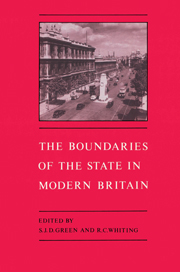Book contents
- Frontmatter
- Contents
- List of figures
- List of tables
- List of contributors
- Acknowledgements
- 1 Introduction: the shifting boundaries of the state in modern Britain
- Part I The state and political theory
- 2 Political thought and the state
- 3 ‘Boundaries’ in theoretical language about the British State
- 4 The twilight of the British state?: Henry Dubb versus sceptred awe
- 5 Thinking about the state and the economy
- Part II The economy
- Part III Welfare and social policy
- Part IV Conflict and order
- Part V Religion and morality
- Index
3 - ‘Boundaries’ in theoretical language about the British State
Published online by Cambridge University Press: 18 March 2010
- Frontmatter
- Contents
- List of figures
- List of tables
- List of contributors
- Acknowledgements
- 1 Introduction: the shifting boundaries of the state in modern Britain
- Part I The state and political theory
- 2 Political thought and the state
- 3 ‘Boundaries’ in theoretical language about the British State
- 4 The twilight of the British state?: Henry Dubb versus sceptred awe
- 5 Thinking about the state and the economy
- Part II The economy
- Part III Welfare and social policy
- Part IV Conflict and order
- Part V Religion and morality
- Index
Summary
When and why did spatial metaphor become part of normative language about the State in Britain? It has acquired so much familiarity in recent years – especially through the Thatcherite topos of ‘rolling back the frontiers of the State’ – that it stands in danger of turning transparent and unremarked. But in failing to notice its pervasive presence we remain blind to a strange and time-specific way of talking about politics. Writers of any period cannot but recognise that any given State has a territorial element: to identify one in relation to another involves stipulating which piece of land or stretch of sea comes under its distinctive, and normally exclusive, sway. So when Alfred Zimmern, all too conscious in 1918 of how States consisted of fields and towns and coasts that might suffer their boundaries to be crossed by invaders, decided on a definition of the State as, ‘a territory over which there is a government claiming unlimited authority’, he hardly said anything worth confuting. The age of imperialism among European powers (and of Frederick Jackson Turner in the United States) had already quickened its romantic language by allowing the frontier a role as cultural metaphor. Wider still and wider shall thy bounds be set; or so it seemed to Lord Appin when he remarked, during one of John Buchan's more excruciating conversations among the imperial elite, that all ‘this modern talk of empire seeks to extend the boundaries of Britain so that a quarter of the world shall be one state’.
Information
- Type
- Chapter
- Information
- The Boundaries of the State in Modern Britain , pp. 29 - 56Publisher: Cambridge University PressPrint publication year: 1996
